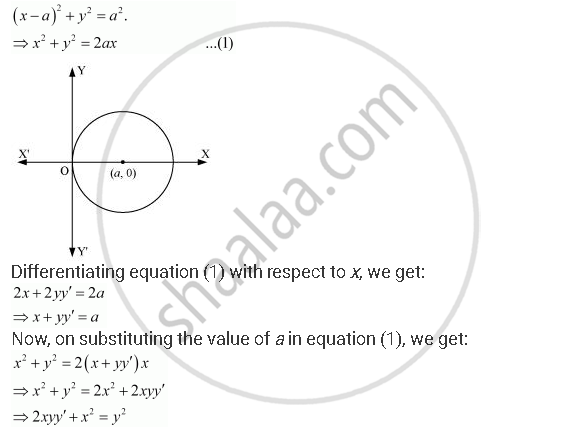Advertisements
Advertisements
प्रश्न
Form the differential equation of the family of circles touching the y-axis at the origin.
उत्तर
The centre of the circle touching the y-axis at origin lies on the x-axis.
Let (a, 0) be the centre of the circle.
Since it touches the y-axis at origin, its radius is a.
Now, the equation of the circle with centre (a, 0) and radius (a) is

This is the required differential equation.
APPEARS IN
संबंधित प्रश्न
Form the differential equation of the family of circles having centre on y-axis and radius 3 units.
Form the differential equation of the family of curves represented by y2 = (x − c)3.
Form the differential equation corresponding to y = emx by eliminating m.
Form the differential equation from the following primitive where constants are arbitrary:
y2 = 4ax
Form the differential equation from the following primitive where constants are arbitrary:
y = cx + 2c2 + c3
Form the differential equation from the following primitive where constants are arbitrary:
xy = a2
Find the differential equation of the family of curves, x = A cos nt + B sin nt, where A and B are arbitrary constants.
Form the differential equation corresponding to y2 = a (b − x2) by eliminating a and b.
Form the differential equation corresponding to y2 − 2ay + x2 = a2 by eliminating a.
Represent the following families of curves by forming the corresponding differential equations (a, b being parameters):
y2 = 4ax
Represent the following families of curves by forming the corresponding differential equations (a, b being parameters):
x2 + (y − b)2 = 1
Show that y = bex + ce2x is a solution of the differential equation, \[\frac{d^2 y}{d x^2} - 3\frac{dy}{dx} + 2y = 0\]
Find the equation of a curve passing through the point (0, 0) and whose differential equation is \[\frac{dy}{dx} = e^x \sin x\]
Find one-parameter families of solution curves of the following differential equation:-
\[\frac{dy}{dx} + 3y = e^{mx}\], m is a given real number.
Find one-parameter families of solution curves of the following differential equation:-
\[x\frac{dy}{dx} - y = \left( x + 1 \right) e^{- x}\]
Write the differential equation representing family of curves y = mx, where m is arbitrary constant.
Write the order of the differential equation representing the family of curves y = ax + a3.
Form the differential equation representing the family of curves y = e2x (a + bx), where 'a' and 'b' are arbitrary constants.
Form the differential equation representing the family of curves y = A sin x, by eliminating the arbitrary constant A.
Find the differential equation of the family of curves y = Ae2x + B.e–2x.
The differential equation representing the family of curves y = A sinx + B cosx is ______.
Form the differential equation of all circles which pass through origin and whose centres lie on y-axis.
Form the differential equation by eliminating A and B in Ax2 + By2 = 1
Find the differential equation of system of concentric circles with centre (1, 2).
Find the equation of a curve passing through (2, 1) if the slope of the tangent to the curve at any point (x, y) is `(x^2 + y^2)/(2xy)`.
Find the equation of the curve through the point (1, 0) if the slope of the tangent to the curve at any point (x, y) is `(y - 1)/(x^2 + x)`
Family y = Ax + A3 of curves will correspond to a differential equation of order ______.
Form the differential equation of family of circles having centre on y-axis and raduis 3 units
